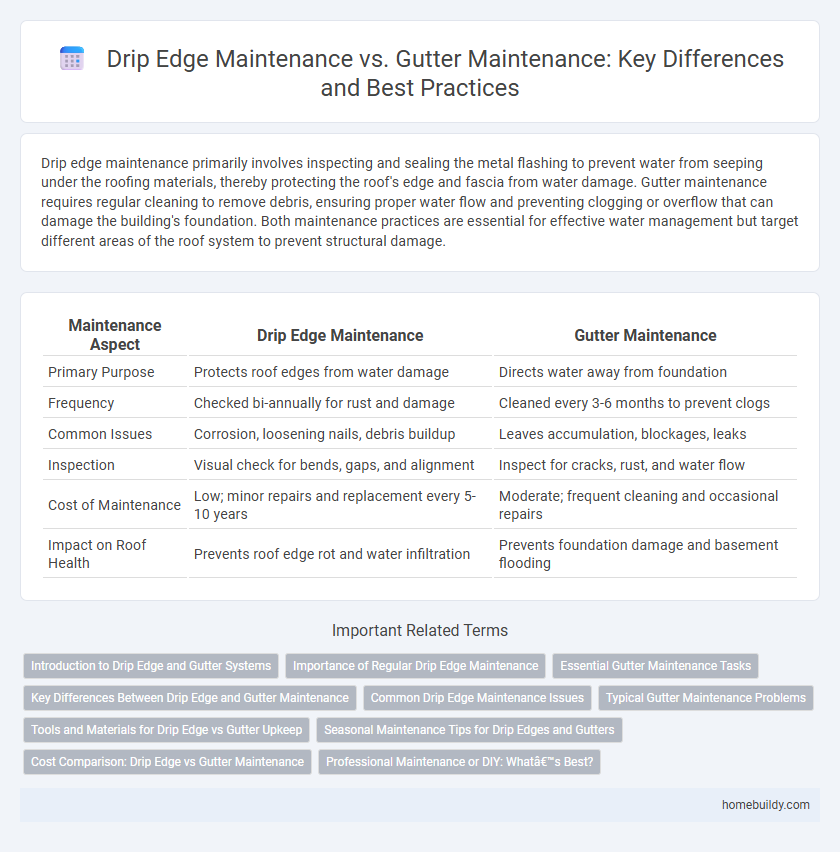Drip edge maintenance primarily involves inspecting and sealing the metal flashing to prevent water from seeping under the roofing materials, thereby protecting the roof's edge and fascia from water damage. Gutter maintenance requires regular cleaning to remove debris, ensuring proper water flow and preventing clogging or overflow that can damage the building's foundation. Both maintenance practices are essential for effective water management but target different areas of the roof system to prevent structural damage.
Table of Comparison
| Maintenance Aspect | Drip Edge Maintenance | Gutter Maintenance |
|---|---|---|
| Primary Purpose | Protects roof edges from water damage | Directs water away from foundation |
| Frequency | Checked bi-annually for rust and damage | Cleaned every 3-6 months to prevent clogs |
| Common Issues | Corrosion, loosening nails, debris buildup | Leaves accumulation, blockages, leaks |
| Inspection | Visual check for bends, gaps, and alignment | Inspect for cracks, rust, and water flow |
| Cost of Maintenance | Low; minor repairs and replacement every 5-10 years | Moderate; frequent cleaning and occasional repairs |
| Impact on Roof Health | Prevents roof edge rot and water infiltration | Prevents foundation damage and basement flooding |
Introduction to Drip Edge and Gutter Systems
Drip edge and gutter systems work together to protect a building's foundation by directing water away from the roof and walls. Drip edge, a metal flashing installed along roof edges, prevents water from seeping under shingles and causing damage to the fascia and roof deck. Gutter maintenance involves clearing debris to ensure proper water flow, while drip edge maintenance focuses on inspecting for rust, securing loose flashing, and ensuring effective water runoff.
Importance of Regular Drip Edge Maintenance
Regular drip edge maintenance is crucial for preventing water damage to roof decking and fascia by ensuring proper water runoff away from the structure. Neglecting drip edge care can lead to roof leaks, wood rot, and compromised gutter efficiency, which impacts overall roof integrity more severely than gutter maintenance alone. Prioritizing drip edge inspections and repairs extends roof lifespan and enhances the effectiveness of gutter systems by directing water flow precisely.
Essential Gutter Maintenance Tasks
Essential gutter maintenance tasks include regular cleaning to prevent clogs, inspecting for leaks or rust, and ensuring downspouts are clear for proper water flow. Drip edge maintenance primarily involves checking for damage or bending to ensure it directs water away from the fascia and prevents roof edge deterioration. While drip edge maintenance protects the roof structure, consistent gutter upkeep is crucial for effective water drainage and preventing foundation damage.
Key Differences Between Drip Edge and Gutter Maintenance
Drip edge maintenance primarily involves inspecting and sealing the metal flashing to prevent water from seeping under roofing materials, thereby protecting the roof's edge and fascia from water damage. Gutter maintenance focuses on cleaning debris, ensuring proper water flow, and repairing leaks to prevent water overflow and foundation damage. Unlike gutters, which require frequent clearing and adjustment, drip edge maintenance is less frequent but crucial for securing the roof's waterproofing and structural integrity.
Common Drip Edge Maintenance Issues
Common drip edge maintenance issues include rust accumulation, warping, and debris buildup that can obstruct water flow, leading to potential roof and fascia damage. Unlike gutter maintenance, which primarily involves clearing leaves and blockages, drip edge upkeep requires inspecting for loose or damaged metal flashing and ensuring proper sealing to prevent water infiltration. Regular drip edge inspections and timely repairs play a crucial role in extending roof lifespan and maintaining effective water drainage.
Typical Gutter Maintenance Problems
Drip edge maintenance primarily involves ensuring the metal flashing remains securely fastened and free from corrosion to protect roof edges from water damage. Typical gutter maintenance problems include clogs from leaves and debris, rusting, sagging, and improper slope that hinder water flow and cause overflow or damage. Neglecting gutters often leads to water pooling near the foundation, while properly maintained drip edges provide a first line of defense against roof and fascia deterioration.
Tools and Materials for Drip Edge vs Gutter Upkeep
Effective drip edge maintenance requires tools such as a flat pry bar, tin snips, roofing nails, and sealant, alongside materials like metal flashing strips that prevent water intrusion beneath roofing shingles. Gutter upkeep involves tools including a gutter scoop, garden hose, ladder stabilizer, and gutter guards, with materials like downspouts, hangers, and debris screens designed to channel water away from the foundation. Proper tool selection and material quality in drip edge and gutter maintenance ensure long-term roof protection and efficient water drainage systems.
Seasonal Maintenance Tips for Drip Edges and Gutters
Seasonal maintenance for drip edges involves inspecting for rust, ensuring proper alignment, and clearing debris buildup to prevent water damage to the roof's edges. Gutter maintenance requires removing leaves, checking for clogs, and securing loose sections to maintain effective water drainage. Regular upkeep of both drip edges and gutters prevents water infiltration and structural damage during heavy rains and winter freezes.
Cost Comparison: Drip Edge vs Gutter Maintenance
Drip edge maintenance typically incurs lower costs compared to gutter maintenance due to its simple design and minimal debris accumulation, requiring only occasional inspection and sealing. Gutter maintenance involves regular cleaning to prevent clogs, repairs for leaks or sagging sections, and sometimes replacement, resulting in higher labor and material expenses. Budgeting for drip edge upkeep offers a cost-effective solution to protect roof edges and prevent water damage, whereas gutter maintenance demands more frequent investment to ensure proper water drainage.
Professional Maintenance or DIY: What’s Best?
Professional maintenance of drip edges ensures precise installation and effective water diversion, reducing risks of roof damage and structural issues. Gutter maintenance often requires frequent cleaning and inspection to prevent clogs and water overflow, which can be labor-intensive for DIYers. While DIY upkeep is possible for gutters, drip edge maintenance benefits significantly from professional expertise to maintain optimal roof protection and longevity.
Drip edge maintenance vs Gutter maintenance Infographic

 homebuildy.com
homebuildy.com